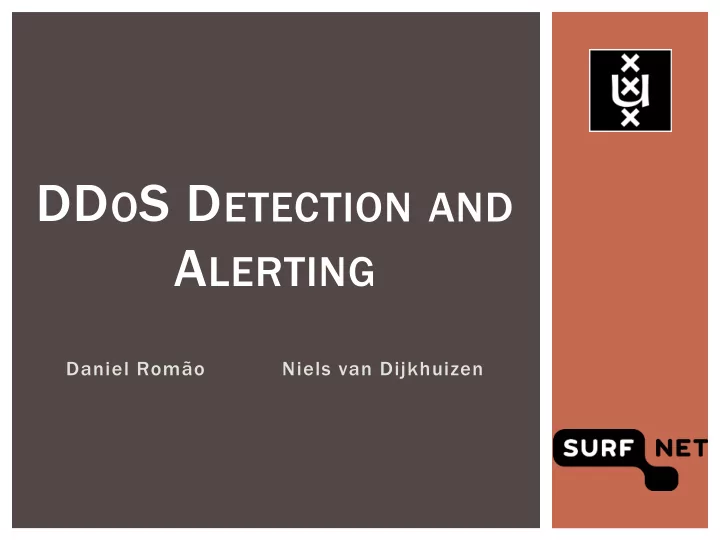

DD O S D ETECTION AND A LERTING Daniel Romão Niels van Dijkhuizen
BACKGROUND DDoS attacks are commonly seen in the SURFnet network Mostly flooding attacks Customers are heavily affected and complain These attacks are cheap and easily performed
BOOTERS / DDOSSERS / STRESSERS
CURRENT SOLUTION What does SURFnet currently use? Fixed threshold alerting IP fragmentation alerting BGP off-ramping and traffic washing Can we make it better?
RESEARCH QUESTIONS “Can we derive DDoS mitigation rules from the available production data in near real- time in order to alert and mitigate?” What kind of DDoS attacks can we detect? Can we detect them in near real-time? Can we extract enough information for mitigation?
WHAT WE PROPOSED
APPROACH 1. Collect one week NetFlow data One on hundred sampling 2. Filter interesting application protocols 53/udp (DNS), 123/udp (NTP), 80/tcp (HTTP), … 3. Categorize traffic by behavior 4. Create baselines Application protocols Rest of the traffic (icmp, tcp, udp)
MODEL
FINDING NEW ANOMALIES
ANALYSIS Correlations: Bytes per packet Source – Destination ratios (symmetry) Categories identified: Regular traffic without noise (e.g. HTTP/TCP) Regular traffic with noise (e.g. DNS/UDP) Non-regular traffic (e.g. NTP/UDP)
EXAMPLE OF BEHAVIORS
Smoothing: (friedman) REGULAR WITH NOISE IQR rule for outliers: Smoothing + offset:
ANALYSIS (CONT.) For the other categories our statistical analysis was not as effective Traffic without noise -> baseline but hand-picked offset Non-regular traffic -> threshold
OUR PROTOTYPE NfSen plugin written in Perl and HTML/PHP Run every five minutes Run-time: 10 seconds Baselines and configuration stored in a SQLite database Adaptive baseline Weighting value E-mail alerting
CONCLUSION What kind of DDoS attacks can we detect? We can detect anomalies based on high volume. However... Verified for profiled application protocols and rest. Due to constraints , we didn’t dive into low -rate anomalies. Can we detect them in near real-time? Yes, within a 5 minutes interval (or even faster) Can we extract enough information for mitigation? No, but we expect that to be possible with further development of the plugin
FUTURE WORK Automate analysis Gather more information to detect the type of the anomaly Make the model distributed Integration with a mitigation system
Cool, right? THANK YOU!
Recommend
More recommend